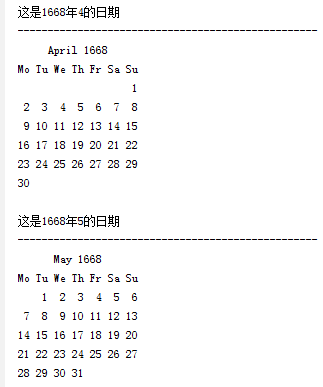import time
#从1970年1月1号凌晨开始到现在的秒数,是因为这一年unix的第一个商业版本上市了,这个最常用
# print(time.time())
# 1491574950.2398355
#返回当前的系统时间,也可加参数,比如下面的第二个例子
# print(time.ctime())
# print(time.ctime(time.time()-86400))
# Fri Apr 7 22:24:17 2017
# Thu Apr 6 22:25:15 2017
#可以把年、月、日、小时、分钟分别显示出来,但是这里显示的时间是格林威治时间,用下面第二个例子就可以做时间的字符串拼接
# print(time.gmtime())
# time_obj = time.gmtime()
# print(time_obj.tm_year,time_obj.tm_mon)
# time.struct_time(tm_year=2017, tm_mon=4, tm_mday=7, tm_hour=14, tm_min=25, tm_sec=59, tm_wday=4, tm_yday=97, tm_isdst=0)
# 2017 4
#上面显示的格林威治时间,下面这里是显示本地时间
# print(time.localtime())
# time.struct_time(tm_year=2017, tm_mon=4, tm_mday=7, tm_hour=22, tm_min=31, tm_sec=42, tm_wday=4, tm_yday=97, tm_isdst=0)
#把一个时间对象转换成时间戳
# print(time.mktime(time_obj))
# 1491546920.0
#等待10s
# time.sleep(10)
# print('wait 10s')
#将时间对象转换成指定的字符串格式,参数有两个,分别是格式和时间对象,你可以选择你想要的时间格式,比如就要日期,或者就时间,或者都要
# print(time.strftime("%Y-%m-%d:%H:%M:%S",time.gmtime()))
# 2017-04-07:14:40:28
# print(time.strftime("%Y-%m-%d:%H:%M:%S",time.localtime()))
# 2017-04-07:22:40:50
# ret = time.strptime('2016-12-23 15:34:34','%Y-%m-%d %H:%M:%S')
# print(ret)
# time.struct_time(tm_year=2016, tm_mon=12, tm_mday=23, tm_hour=15, tm_min=34, tm_sec=34, tm_wday=4, tm_yday=358, tm_isdst=-1)
import datetime
#显示今天的日期
# print(datetime.date.today())
# 2017-04-07
# ret = datetime.datetime.now()
# print(ret)
# 2017-04-07 22:48:18.861383
#转换time的形式
# print(ret.timetuple())
# time.struct_time(tm_year=2017, tm_mon=4, tm_mday=7, tm_hour=22, tm_min=49, tm_sec=46, tm_wday=4, tm_yday=97, tm_isdst=-1)
#下面介绍下时间的加减
#给当前的时间加10天
# print(datetime.datetime.now() + datetime.timedelta(days=10))
# 2017-04-17 22:55:03.070503
#给当前时间减10天
# print(datetime.datetime.now() + datetime.timedelta(days=-10))
# print(datetime.datetime.now() - datetime.timedelta(days=10))
# 2017-03-28 22:56:08.529247
# 2017-03-28 22:56:08.529247
#上面的例子是加减天,其实timedelta可以支持加减下面的参数,比如周,小时,分钟
# days=0, seconds=0, microseconds=0,milliseconds=0, minutes=0, hours=0, weeks=0):
#
current_time = datetime.datetime.now()
print(current_time)
#替换为某年,某月,某日
print(current_time.replace(2016,1,3))
print(current_time.replace(2016,3))
print(current_time.replace(2015))
# 2016-01-03 23:01:54.095012
# 2016-03-07 23:01:54.095012
# 2015-04-07 23:01:54.095012
#两个时间还可以做比较
# gtime = datetime.datetime.now()
# ctime = gtime.replace(2015)
# if gtime > ctime:
# print('true')
# else:
# print('false')
今天发现一个新的模块,这个模块显示日历比较好,所以在这里做下记录,模块的名称就叫做"calender",下面是简单的用法
import calendar
# year = 1987
# month_num = 1
for year in range(1000,2101):
for temp in range(1,13):
cal = calendar.month(year,temp)
print("这是{0}年{1}的日期".format(year,temp))
print("--------------------------------------------------")
print(cal)
最终的结果截图如下,是不是和拉轰啊!

时间戳转换为时间格式
import time def convert_stamp(a): timeArray = time.strptime(a, "%Y-%m-%d %H:%M:%S") timeStamp = int(time.mktime(timeArray)) return int(timeStamp) r = convert_stamp(str(i["latest_time"])) print(r + 28800)